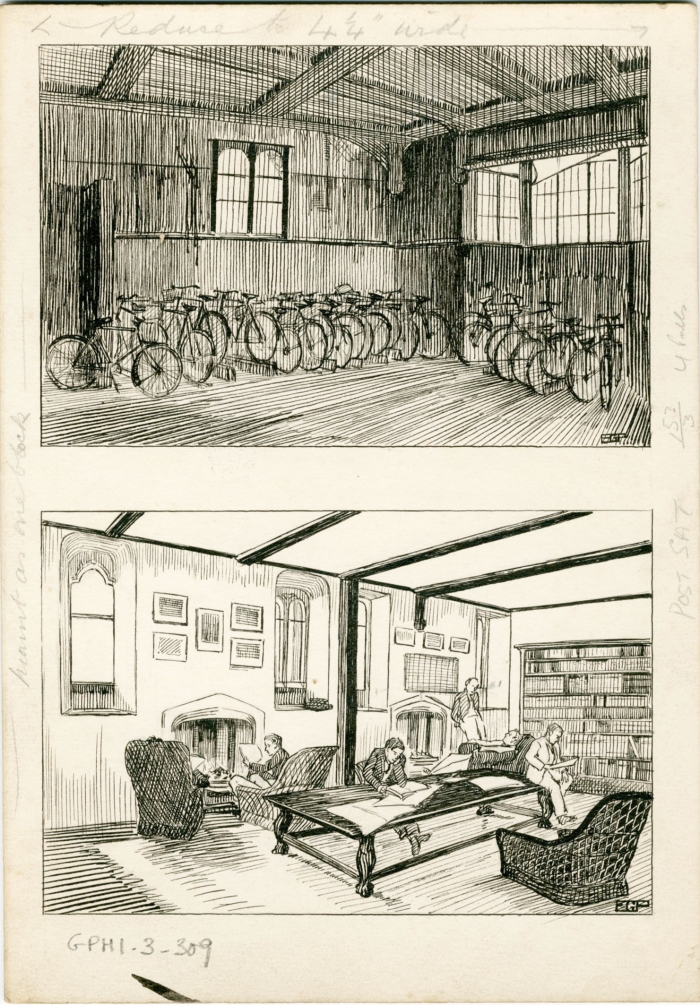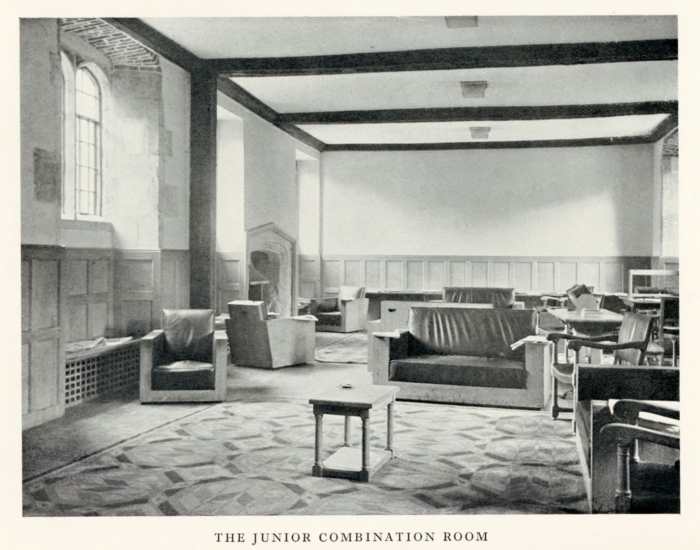Junior Combination Room
Pen and Ink drawings on one card of (above) the bicycle store in II and K1 First Court, and (below) that store as converted into the Junior Combination Room in 1931. The furnishings are, however, different from those in G.E Briggs' photograph in The Eagle vol 47 (facing p.55), and this is presumably an artist's impression of the finished room.
In June 1932, an article by JS Boys-Smith, the first Council appointed Treasurer of the new JCR, appeared in the Eagle describing the long road to the creation and expansion of the JCR. The article from Vol 47 is reproduced below.
For some time it had been felt that the undergraduates’ Reading Room on the ground floor under Lecture Room I in the First Court, established by an order of the Council in the Easter Term 1902, was inadequate to the needs of the College. In the Easter Term 1931, it was finally decided to convert the Bicycle Room, which occupied most of the ground floor range buildings to the south of the Gate Tower in the First Court, into a Junior Combination Room [JCR]. This plan had been suggested as early as 1927.
The room, which is under the original College Library, was formed by throwing together two sets of chambers. The northern part, approached from the turret of the Gate Tower, was the set known latterly as K1; the southern part formed a portion of the set II, approached from the staircase in the south-east corner of the First Court. K1 was converted into a Bicycle Room in the Michaelmas Term 1898; and this was enlarged in the Lent Term1911 by taking in a portion of I1.
I1 was once two sets, numbered according to the numeration, 7 and 9, the latter, in the south-east corner, being commonly known as the Garden Chamber. It was a part of 7 only that was taken to enlarge the Bicycle Room.
The conversion of the Bicycle Room was begun during the Long Vacation 1931, the bicycles being accommodated in a building in the Kitchen Lane; and the [JCR] was opened in February of this year [1931]. The upper part of the walls was re-plastered, and the deal wainscoting replaced by oak panelling. The deal floor, which rested on joists, was replaced by an oak floor laid on concrete. The brick arches over the windows were exposed. The small turret room in the north-east corner serves as a telephone room. The two original clunch fire-places on the east side were repaired. The north wall, when exposed, was found to consist almost entirely of large blocks of clunch, on two of which are carvings; the more interesting of these is left exposed. On the stonework surrounding some of the windows (those of K1) are remains of a leaf design in red: this survives where the blocks are of true stone, but it had perished where the blocks are of clunch.
The work was carried out by Messrs Rattee and Kett, Ltd., of Cambridge, under the direction of Mr William Weir as architect. The furniture and electric light fittings were supplied by Messrs Heal and Son, Ltd., of Tottenham Court Rd, London.
Part of the cost of the room was borne by a legacy to the College from the late William Albert Cox (BA,1867), Fellow of the College from 1868 to his death in 1923, Lecturer in Theology from 1885 to 1905, Junior Dean from 1882 to 1886, and Senior Dean from 1886 to 1894.
The [JCR] is under the management of a Treasurer, appointed by the Council, and a Committee of junior members of the College.
This Special Collections Spotlight article was contributed on 15 October 2013 by the Archivist.

